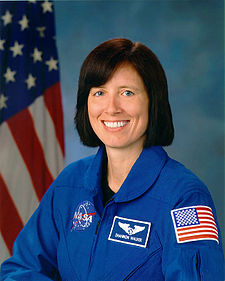Shannon Walkerová
| Shannon Baker Walkerová | |
|---|---|
 | |
| Astronautka NASA | |
| Státní příslušnost | |
| Datum narození | 4. června 1965 (57 let) |
| Místo narození | Houston, Texas, USA |
| Předchozí zaměstnání | inženýrka NASA |
| Čas ve vesmíru | 330 dní, 13 hodin a 40 minut |
| Kosmonaut od | 6. května 2004 |
| Mise | Expedice 24/25 (Sojuz TMA-19/ISS) Expedice 64/65 (Crew-1/ISS) |
| Znaky misí | |
| Kosmonaut do | dosud aktivní |
| Některá data mohou pocházet z datové položky. | |
Shannon Baker Walkerová (* 4. června 1965 Houston, Texas, USA) je americká astronautka. Jako 515. člověk ve vesmíru se zúčastnila dvou misí na Mezinárodní vesmírnou stanici (ISS). V roce 2010 v Sojuzu TMA-19, v roce 2020 ve SpaceX Crew-1. Její lety trvaly celkem 330 dní, 13 hodin a 40 minut. Je vdaná za astronauta Andrewa Thomase.[1]
Život
Studium a zaměstnání
Shannon Walkerová v rodném Houstonu roku 1983 dokončila střední školu a poté také Riceovu univerzitu, kde se roku 1987 se stala bakalářkou z fyziky a o pět let později magistrou z astrofyziky. Roku 1993 získala z astrofyziky i doktorát. Současně už od roku 1987 pracovala v Johnsonově vesmírném středisku NASA.[1][2]
Astronautka
Počínaje 15. náborem NASA roku 1994 se hlásila mezi astronauty, uspěla až po deseti letech při 19. náboru a 6. května 2004 byla zařazena do oddílu. Absolvovala všeobecnou kosmickou přípravu a v únoru 2006 získala kvalifikaci letové specialistky.[2]
V červenci 2008 byla jmenována do záložní posádky Expedice 21 (start v září 2009) a hlavní posádky Expedice 24 se startem v květnu 2010.[2] V září 2008 bylo její jmenování bylo oficiálně potvrzeno.[3] Do kosmu odstartovala z Bajkonuru 15. června 2010 ve 21:35 UTC v Sojuzu TMA-19, společně s Fjodorem Jurčichinem a Douglasem Wheelockem.[4] Na ISS strávila přes pět měsíců ve funkci palubní inženýrky Expedic 24 a 25. Vrátila se v Sojuzu TMA-19 s Jurčichinem a Wheelockem. Přistáli 26. listopadu ve 4:46 UTC v Kazachstánu, 84 km severně od Arkalyku[5] po 163 dnech, 7 hodinách a 11 minutách letu.
Dne 31. března 2020 byla vybrána na let Crew-1, první řádnou misi lodi Dragon Crew společnosti SpaceX. Ke svému druhému letu do vesmíru odstartovala v posádce, jejímiž členy dále byli Michael Hopkins, Victor Glover a Sóiči Noguči, z Kennedyho vesmírného střediska 16. listopadu 2020 v 00:27 UTC. Po připojení k ISS se stala letovou specialistkou Expedice 64. Před odletem velitele expedice Sergeje Ryžikova v Sojuzu MS-17 od něj 15. dubna 2021 převzala funkci a v prvních 12 dnech Expedice 65 byla její velitelkou. Následně od ní 27. dubna 2021 funkci převzal Akihiko Hošide a Shannon Walkerová se zbytkem své posádky a ve své lodi opustila ISS a přistála v Mexickém zálivu nedaleko pobřeží Floridy 2. května 2021 v 6:56 UTC, tedy po 167 dnech, 6 hodinách a 29 minutách letu.[6]
Reference
- ↑ a b Biographical data. Shannon Walker [online]. NASA, rev. 2009-08 [cit. 2009-10-19]. Dostupné v archivu pořízeném dne 2014-07-04. (anglicky) – Oficiální biografie NASA
- ↑ a b c IVANOV, Ivan, a kol. Космическая энциклопедия ASTROnote [online]. Moskva: rev. 2009-09-30 [cit. 2009-10-19]. Kapitola Shannon Baker Walke. Dostupné online. (rusky)
- ↑ Пресс-служба Роскосмоса. Предварительный план-график экспедиций на МКС и смен экипажа на кораблях «Союз» (с июня 2008г. по ноябрь 2010г.) [online]. Moskva: Roskosmos, 2008-09-21 [cit. 2009-10-15]. Dostupné online. (rusky)[nedostupný zdroj]
- ↑ STRAKA, Vít. Záznam online přenosu startu lodi Sojuz TMA-19 [online]. Česká astronomická společnost, rev. 2010-6-15 [cit. 2010-06-16]. Dostupné online.
- ↑ VÍTEK, Antonín. SPACE 40 Velká encyklopedie družic a kosmických sond [online]. Praha: rev. 2010-11-29 [cit. 2010-12-04]. Kapitola 2010-029A - Sojuz-TMA 19. Dostupné online.
- ↑ NORTHON, Karen. Crew-1 Astronauts Safely Splash Down After Space Station Mission. NASA [online]. 2021-05-02 [cit. 2021-05-13]. Dostupné online.
Externí odkazy
 Obrázky, zvuky či videa k tématu Shannon Walkerová na Wikimedia Commons
Obrázky, zvuky či videa k tématu Shannon Walkerová na Wikimedia Commons - NASA: Biografie (en)
Média použitá na této stránce
The mission patch design for the 25th Expedition to the International Space Station (ISS) pays tribute to the rich history of innovation and bold engineering in the quest for knowledge, exploration and discovery in space. The patch highlights the symbolic passing of the torch to the ISS, as the vehicle that will carry us into the future of space exploration. The Space Shuttle Program emblem is the foundation of the patch and forms the Greek letter 'Alpha' with a new dawn breaking at the center, symbolizing a new vision for space exploration. The Alpha symbol is overlaid by the Greek letter 'Omega', paying tribute to the culmination of the Space Shuttle Program. The mission designation '25' is shown centered at the bottom of the patch, symbolizing the point in time when the Space Shuttle, the workhorse of the ISS assembly process, will make its final visit to the ISS. Between the '25' and the Earth crescent, the orbiter is shown returning to Earth on its final journey, during the Expedition 25 mission. Above Earth and the breaking dawn, the ISS takes center-stage, completed and fully equipped to carry us beyond this new dawn to new voyages and discoveries. The orbit connecting the ISS and the Earth is drawn in the colors of the United States and Russian flags; paying tribute to the blended heritage of the crew. The two largest stars in the field represent the arrival and departure of the crews in separate Russian Soyuz vehicles. The six stars in the field represent the six crew members. The International Space Station abbreviation 'ISS' and 'MKC' - in English and Russian, respectively - flank the mission number designation, and the names of the crew members in their native languages border the ISS symbol.
International Space Station (ISS) Expedition 64 mission insignia
- The Expedition 64 patch shows the International Space Station illuminated by the city lights of earth. The illumination of the space station modules represents the enduring partnership and continuous human presence on station for 20 years. The modules from all partner countries represent the international cooperation, which sustains this presence in space. The aurora and light behind the horizon are beautiful features of our home planet, and the Moon and stars in the background shows our future exploration beyond Earth.
Astronaut Shannon Walker
International Space Station (ISS) Expedition 65 mission insignia
- The International Space Station Expedition 65 patch depicts the space station as it appears during the time the crew will be onboard. The space station flying over the Earth represents the overall reason for having a space station; to benefit the world through scientific research and international cooperation in space. When this expedition begins, the space station will have provided continued human presence in space for more than twenty years. Blue, the background color of the patch, symbolizes reliability.
- The stars represent the crew onboard the space station, as well as mission control centers located on three continents. Those stars, in that field of blue, also symbolize the thousands of space workers throughout the space station partnership who continue to contribute to the success of our International Space Station.
The official crew patch for Expedition 24, the 24th long-duration mission to the International Space Station.
- Science and Exploration are the cornerstones of NASA's mission onboard the International Space Station (ISS). This emblem signifies the dawn of a new era in our program's history. With each new expedition, as we approach assembly complete, our focus shifts toward the research nature of this world-class facility. Prominently placed in the foreground, the ISS silhouette leads the horizon. Each ray of the sun represents the five international partner organizations that encompass this cooperative program. Expedition 24 is one of the first missions expanding to a crew of six. These crews, symbolized here as stars arranged in two groups of three, will launch on Soyuz vehicles. The unbroken flight track symbolizes our continuous human presence in space, representing all who have and will dedicate themselves as crew and citizens of the International Space Station.






